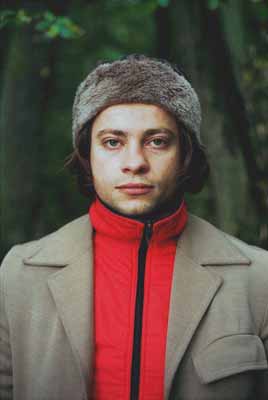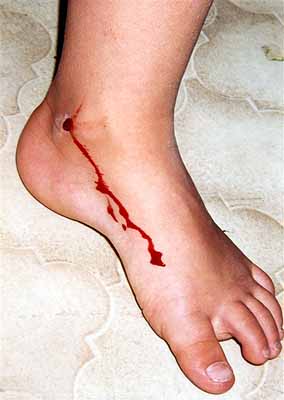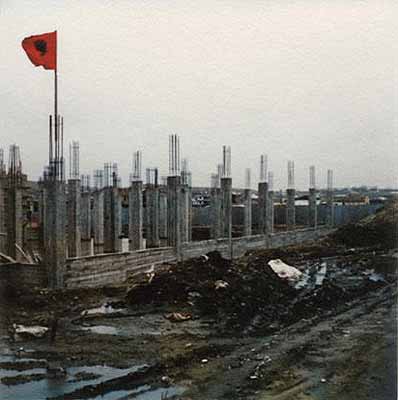
fotografenbüro
Sylvia Chybiak » Jens Liebchen » Wiebke Loeper » Florian Profitlich » Peter Thieme » Philipp von Recklinghausen »
Exhibition: 2 Mar – 13 Apr 2005
Photographic Center Northwest
900 12th Avenue
WA 98122-4412 Seattle
+1-206-7207222
Mon 12-21:30 . Tue-Sun 9-21:30
Lee Friedlander once remarked in a graduate seminar that " the real world was so interesting and bizarre that it provided an endless array of material with which to work " This is certainly the case for the images in Fotografenbüro, an exhibition of the work of lux, the Berlin based photo bureau whose work is being presented in the United States for the first time. Each of these six photographers has a distinctly different approach to image making from the highly conceptual work of Jens Liebchen’s "Red Flag" series to the lyrical, autobiographical work of Wiebke Loeper. The work of Peter Thieme deals with the topography of East Germany where as Florian Profitlich uses a panoramic camera to record architectural and topographical change in Berlin. The imagery of Sylvia Chybiak and Philipp von Recklinghausen on the other hand is charged with emotion yet each arrives at it by a different path. Liebchen’s RED FLAG photos were taken while driving through Albania in 1999. Struck by the constant appearance of these red flags atop buildings under construction, he decided to document them using a Polaroid SX-70 a format which produces a unique print. The use of the SX-70 was a deliberate attempt to differeniate the work from another series he had undertaken at the same time. "I used the Polaroid because I wanted a different size frame." He was also drawn to the color palette of the Polaroid which changes over time and which he felt would enhance the importance of the flags with time. Even so, it was not until some years later, far removed from the immediate experience that these images began to take on specific meaning…and mystery. It was at this point that Liebchen developed the syntax for the final presentation - a hybrid giclee print derived from the original Polaroids which, in addition to being slightly larger, enhance the language of the Polaroid and take it further…. in terms of color, and density. Wiebke Loeper who grew up in East Berln has continuously used her camera to explore her childhood, psychologically as well as geographically. Perhaps more than any of her colleagues at lux, Berlin is her personal territory in the way, say, that New York was Helen Levitt’s territory and her work is inseparable from that city. Loeper is the consummate Berlin insider and in her images past, present and future are all intertwined within a highly personal narrative which gives her photographs multiple levels of meaning. There are the formal and biographical aspects as well as the historical context of a city, once divided and now unified through which she seems to effortlessly weave her way, both geographically and ideologically. Sylvia Chybiak’s series, "Childhood," represents a strong departure from her earlier black and white work which was strongly inspired by American photographers Robert Frank and Walker Evans, and is inspired by her four year old son, Victor and her experiences as a new mother. The work simultaneously explores the concept of childhood as an ideal and the reality of it as something precious, highly vulnerable and extremely fleeting. She is not afraid to explore the sensuousness of childhood in her work but her approach is far different from that of Sally Mann… Using her son and his friends, Chybiak creates archetypes which explore the boundaries of the idea of the nuclear family. Having grown up in the DDR like her colleague Wiebke Loeper, her ideas, experiences and outlook are shaped by a social and political structure which is in the process of evolving as it attempts to sort out its past at the same time as it deals with the encroachment of the values and ideas of the west. Peter Thieme’s images are at once quirky and funny. They are a serious commentary on the changes he has observed in East German society and in particular the landscape. With a keen eye for what is in front of the camera he has for over 10 years documented the landscape in Berlin and its environs. In this particular group of images entitled, "After Mining" Thieme obliquely comments on the transformation of an area of open pit mining (in the DDR) with the reclamation of the same in the new Germany. He shows in subtle contexts the everyday ironies of this area as it struggles to become modernized. The images are precisely framed to control the viewer’s mind and eye and through a kind of formal beauty present both the horror of the past and a "new" horror in the making…the success of the corporation over the individual. Philipp von Recklinghausen photographs his subjects, all people he knows, at the moment when the sitter’s face is at it’s most relaxed state believing that at this moment the "true" state of the subject is revealed. Through very formal limits, in distance, plane of focus, and placement within the frame, he hopes to strip away the variables and allow us to concentrate on the face and it’s typography as a way into the psychology of the people he has chosen to photograph. Yet his work, which grows out of his experiences in Bosnia as a photo-journalist in 1993, is also an attempt to use his camera to explore his own psyche. He is searching for something in himself in the faces of others. Florian Profitlich’s mission is nothing less than an attempt to chronicle the look of Berlin. Through a series of panoramic black and white photographs he shows us the changing structure of the city after unification and as it again becomes the capitol of Germany. His concern is with the brick and mortar of the city and how this suggests the future. Working in a very traditional way, with the sensibility of a historian, he has set out to record the essence of a particular Berlin before it is built over or re-styled into something hardly recognizable. Often his viewpoint perched from above creates a "god-like" view of the city akin to some of the important work from photography’s early years in the 19th century. In this period photographers often gave us viewpoints not commonly available to the audience. This in turn reflected a certain "ecclesiastical" sensibility about the subject. Profitlich explores this with an extended syntax…point of perspective and by employing the panorama format. [?] The use of a special camera that allows up to a 360-degree image affords us an opportunity to look not only from a vantage point not common but also with a sweep and a degree of detail we seldom do with our naked eyes. If the images shown here have a common thread, it is that each of these six photographers works in the real world. Although there is a high degree of craftsmanship apparent in the work, there is nothing slick here. No effort is made to manipulate the image, rather to present images with clarity and honesty. This exhibition will begin in Seattle in March 2005 and travel in the USA. Sites include-Hampshire College Film and Photography Gallery, Amherst, Massachusetts. The exhibition is in part supported by PCNW, The Goethe Institute of San Fransisco and Western Bridge, Seattle.


